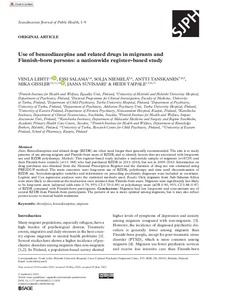Use of benzodiazepine and related drugs in migrants and Finnish-born persons: a nationwide register-based study
Lehti Venla; Salama Essi; Niemelä Solja; Tanskanen Antti; Gissler Mika; Suvisaari Jaana; Taipale Heidi
https://urn.fi/URN:NBN:fi-fe2022091258708
Tiivistelmä
Aims: Benzodiazepines and related drugs (BZDR) are often used longer than generally recommended. The aim is to study patterns of use among migrant and Finnish-born users of BZDR, and to identify factors that are associated with long-term use and BZDR polytherapy.
Methods: This register-based study includes a nationwide sample of migrants (n=8729) and their Finnish-born controls (n=11 388) who had purchased BZDR in 2011-2014, but not in 2009-2010. Information on drug purchases was obtained from the National Prescription Register and the duration of drug use was estimated using PRE2DUP method. The main outcomes were long-term use of BZDR, polytherapy and time until discontinuation of BZDR use. Sociodemographic variables and information on preceding psychiatric diagnoses were included as covariates. Logistic and Cox regression analyses were the statistical methods used.
Results: Only migrants from Sub-Saharan Africa were more likely to discontinue the medication once initiated than Finnish-born users. Migrants were significantly less likely to be long-term users (adjusted odds ratio 0.79, 95% CI 0.70-0.89) or polytherapy users (aOR 0.90, 95% CI 0.84-0.97) of BZDR compared with Finnish-born participants.
Conclusions: Migrants had less long-term and concomitant use of several BZDR than Finnish-born participants. The pattern of use is more optimal among migrants, but it may also reflect poorer access to mental health treatment.
Kokoelmat
- Rinnakkaistallenteet [27094]
